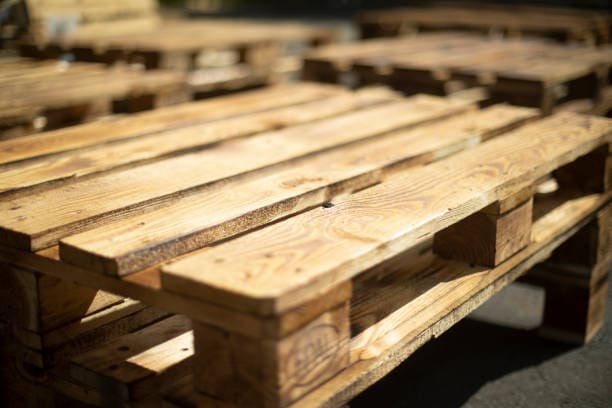Industrial wood products are used in a variety of applications and offer many advantages. They can be made from a wide range of species, including hardwood and softwood. They can also be machined to meet a company’s specific specifications.
The world of the wood products industry faces numerous challenges and complexities. For example, there is a need to improve timber supply and address illegal logging.
Pallets
Wooden pallets are a common sight in industrial settings, serving as storage tools and vehicles for a wide variety of products. They also play an essential role in imports and exports, allowing businesses to bring in products from abroad and ship them back out again. But what else can these handy wooden platforms do? Wooden pallets are versatile, affordable, and highly effective tools that can make your business more productive.
A pallet consists of wooden slats fixed to several feet that allow for easy lifting with automated equipment such as forklifts and conveyor systems. They are available in a wide range of sizes to meet specific industry needs, including those used by the grocery industry. Wooden pallets made from softwoods such as pine are often preferred for their cost-effectiveness and superior strength-to-weight ratio. They are more flexible than hardwood lumber for pallets, and they also resist fungi, rot, and pests better.
When stacked properly, wooden pallets offer full support and protection for the goods they carry. This helps minimize risks to the products and the handling workers, resulting in greater productivity and efficiency. In addition, pallets are often designed with features that promote safety and ease of use. For example, they may include notches for banding and strapping and four-way fork entry to accommodate forklift tines.
Depending on the type of product, the use of wood pallets may require additional features of engineering that prevent damage to the product or packaging. For instance, some electronic devices are sensitive to static charges, which can destroy their components. To protect these items, companies can use anti-static wooden pallets that are engineered to disperse static electricity.
Industrial wooden pallets are also ideal for storing fast-moving consumer goods. These are items that sell quickly, and they usually need to be shipped in bulk. To save time and money, these businesses can stack their items on wooden pallets to reduce shipping costs and ensure customers that their products are delivered in perfect condition.
The proper use of wooden pallets in industrial transport and warehouse operations hinges on adherence to operational standards and quality and safety considerations. For example, the pallets must be inspected for splinters and nails that can puncture and injure handlers. They must also be treated to comply with ISPM-15 regulations, which protect the biodiversity of receiving countries from invasive organisms transmitted by wooden pallets. The treatment process involves heating the pallets in a steam or dry kiln heat chamber or chemical fumigation with methyl bromide or sulfuryl fluoride.
Dunnage
Every business that ships products faces risks of in-transit damage. This may result in expensive repairs or lost sales from upset customers. It is important to mitigate these risks by using the right dunnage for shipping. There are many types of dunnage, from wood to crinkle paper and air pillows, all of which can help protect your products from damage during transit.
The type of dunnage you choose depends on the nature of your shipment. Fragile items require extra cushioning, while heavy cargo needs strong support structures. You also need to consider different transportation modes. Trucking will require consideration of vibration and road conditions, while air transport will involve addressing issues like turbulence and moisture. For maritime shipping, you may need to address saltwater exposure and wave impact.
Dunnage can be made of a variety of materials, including foam, bubble wrap, crinkle paper, and recycled kraft paper. You must select a material that suits your specific shipment and can be easily shaped to fit the space. You should also look for a lightweight material, as this will reduce shipping costs.
If you’re looking for a more environmentally friendly dunnage option, try using shredded paper or plastic packing foam. This material is a great choice for e-commerce shipments as it is inexpensive and easy to shape. It can also be reused, which is good for the environment and your bottom line.
Another popular dunnage option is molded Styrofoam, which is an excellent material for providing shock absorption and protecting fragile items. It is also available in a wide range of colors and sizes, which makes it ideal for packaging.
Whether you’re shipping goods to a customer or just need to secure your industrial wood products themselves, dunnage can make all the difference in the quality of your products and the safety of your workers. It is an investment that can pay off in the long run by preventing damages and reducing labor costs. The right dunnage can also improve your company’s brand image and increase revenue. When in doubt, ask your local industrial wood products supplier about the best dunnage for your needs.
Floor Joists
Floor joists are structural elements that support the weight of flooring, walls, and other building components. They also allow designers to create custom architectural features, such as vaulted ceilings and skylights. Whether using traditional or engineered wood, the flooring, and joists offer stability and longevity. They can be a cost-effective choice compared to other construction materials, and they are available in a wide variety of sizes and shapes.
The strength of wood floor joists is partly due to their cellular structure, which helps them distribute loads evenly and prevent sagging over time. They can also be easily cut on-site to accommodate changes in design or structure, allowing builders to meet unique project requirements.
Load capacity is a key consideration when using joists to build any structure. It’s important to understand how these wood products are designed and built to ensure that they can safely hold the weight of a structure.
A joist’s strength depends on its size, type of material, and how it is installed. For example, a 2×6 joist can span a shorter distance than a 2×12. The spacing between joists also impacts the load-bearing capacity of the structure. For example, wider spacing between joists allows them to carry more weight than narrower spaces.
To determine the right joist size for a specific project, builders must consider both live and dead loads. They must also take into account the location of the structure and the climate conditions it will be exposed to. For example, a building in an area with high wind speed may require longer spans of wood floor joists than a building in a climate with milder weather.
The best wood for floor joists is redwood or cedar, as these species have superior strength and durability. They can withstand the stresses of heavy loads and varying temperatures. They are also less likely to rot or deteriorate over time. In addition, they are sustainable from cradle to grave, as they are sourced through responsible forestry practices.
Engineered wood floor joists can save builders time and money on a construction project by simplifying framing, making floors flatter, and ensuring that the home or building performs as intended. These wood products are available in common-sized sizes for today’s residential and multi-family construction projects. LVL, plywood, or rim board is another option, which provides additional strength while eliminating the need to cut and measure traditional lumber on site.
Beams
Wood beams are a vital part of any structure and are commonly used to support the roof of a building. They can also be used for other purposes, such as supporting walls and columns. Wood is an excellent material for creating beams because it is strong, durable, and aesthetically pleasing. There are many different types of wooden beams, and each type has its unique advantages.
Beams can be made from a single piece of solid wood or they can be manufactured using a manufacturing process called finger-jointing. This manufacturing technique optimizes the use of forest resources and allows for the creation of long lengths of timber. These timbers can be joined together using waterproof adhesive to meet the required set dimensions. In addition, a variety of joints can be used to prevent the occurrence of structural failures or movements within the beams.
Glulam beams are stress-rated engineered wood products that excel in strength and integrity. They are available in both stock and custom sizes, as well as four appearance classifications: premium, architectural, industrial, and framing. They are made with wood laminations, or lams, that are bonded together with moisture-resistant glues. The lams are arranged so that the grain runs parallel to the length of the beam.
These beams are ideal for construction projects that require high load-bearing capacity and can accommodate large spans. They are also suitable for projects with tight budgets and delivery schedules. In addition, glulam is environmentally friendly and offers the advantages of recycled wood products.
Another type of engineered wood product is a laminated veneer lumber (LVL) beam. This is a type of structural wood that is created by layering thin sheets of wood veneer and bonding them together with adhesive. This type of wood is more flexible than glulam, but it is still extremely strong and durable. It is also easy to cut to allow piping and penetrations for plumbing and electrical work.
Engineered wood beams are versatile and can be used for many types of projects. They can be shaped to fit the specific needs of a project, and they are often lighter than steel beams. They are also more economical than other construction materials, such as steel and concrete. In addition, they are a good option for buildings that need to be fire-rated.






